An Alternative Perturbation and Observation Modifier Maximum Power Point Tracking of PV Systems
Abstract
:1. Introduction
2. Maximum Power Point
3. Conventional Perturbation and Observation Algorithm
4. Modified Perturbation and Observation Algorithm
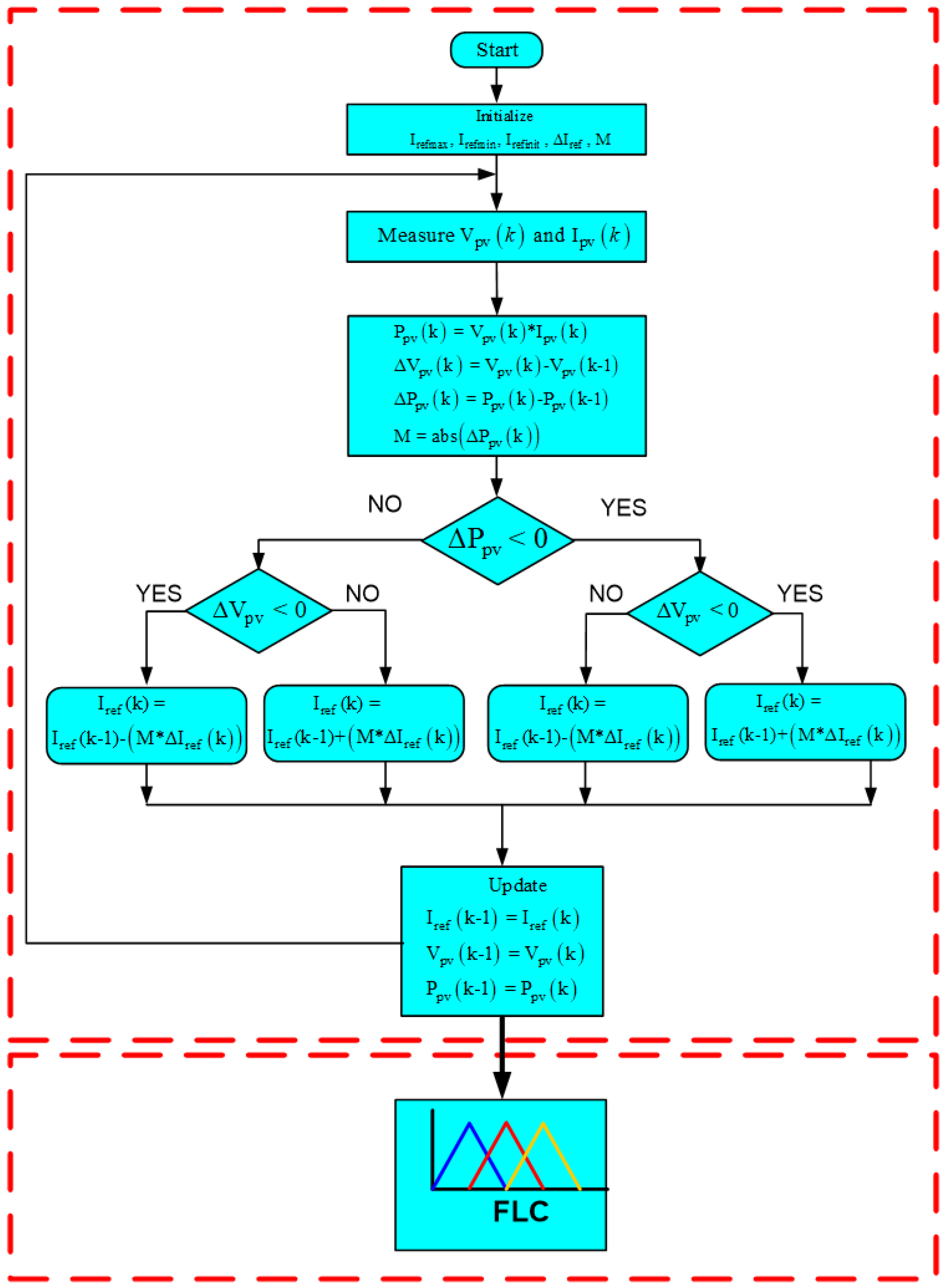
5. Simulation Results
5.1. Maximum Power Point Tracking
5.2. Comparison of Response Time
5.3. Comparison of Ripple
5.4. Comparison of Efficiency
6. PV MPPT System Experiment Results
7. Conclusions
Author Contributions
Funding
Institutional Review Board Statement
Informed Consent Statement
Data Availability Statement
Acknowledgments
Conflicts of Interest
References
- Özbay, H. PDM-MPPT based solar powered induction heating system. Eng. Sci. Technol. Int. J. 2020, 23, 1397–1414. [Google Scholar] [CrossRef]
- Ebrahim, M.A.; Osama, A.; Kotb, K.M.; Bendary, F. Whale inspired algorithm based MPPT controllers for grid-connected solar photovoltaic system. Energy Procedia 2019, 162, 77–86. [Google Scholar] [CrossRef]
- Bielskis, E.; Baskys, A.; Valiulis, G. Controller for the Grid-Connected Microinverter Output Current Tracking. Symmetry 2020, 12, 112. [Google Scholar] [CrossRef] [Green Version]
- Prabpal, P.; Kongjeen, Y.; Bhumkittipich, K. Optimal Battery Energy Storage System Based on VAR Control Strategies Using Particle Swarm Optimization for Power Distribution System. Symmetry 2021, 13, 1692. [Google Scholar] [CrossRef]
- Mao, M.; Cui, L.; Zhang, Q.; Guo, K.; Zhou, L.; Huang, H. Classification and summarization of solar photovoltaic MPPT techniques: A review based on traditional and intelligent control strategies. Energy Rep. 2020, 6, 1312–1327. [Google Scholar] [CrossRef]
- Yap, K.Y.; Sarimuthu, C.R.; Lim, J.M.Y. Artificial Intelligence Based MPPT Techniques for Solar Power System: A review. J. Mod. Power Syst. Clean Energy 2020, 8, 1043–1059. [Google Scholar]
- Benhadouga, S.; Meddad, M.; Eddiai, A.; Boukhetala, D.; Khenfer, R. Sliding Mode Control for MPPT of a Thermogenerator. J. Electron. Mater. 2019, 48, 2103–2111. [Google Scholar] [CrossRef]
- Abdullah, M.A.; Al-Hadhrami, T.; Tan, C.W.; Yatim, A.H. Towards Green Energy for Smart Cities: Particle Swarm Optimization Based MPPT Approach. IEEE Access 2018, 6, 58427–58438. [Google Scholar] [CrossRef]
- Ahmed, J.; Salam, Z. An Enhanced Adaptive P&O MPPT for Fast and Efficient Tracking under Varying Environmental Conditions. IEEE Trans. Sustain. Energy 2018, 9, 1487–1496. [Google Scholar]
- Zhou, C.G.; Huang, L.; Ling, Z.X.; Cui, Y.B. Research on MPPT control strategy of photovoltaic cells under multi-peak. Energy Rep. 2021, 7, 283–292. [Google Scholar] [CrossRef]
- Jately, V.; Azzopardi, B.; Joshi, J.; Venkateswaran, V.B.; Sharma, A.; Arora, S. Experimental Analysis of hill-climbing MPPT algorithms under low irradiance levels. Renew. Sustain. Energy Rev. 2021, 150, 111467. [Google Scholar] [CrossRef]
- Javed, K.; Ashfaq, H.; Singh, R. An improved MPPT algorithm to minimize transient and steady state oscillation conditions for small SPV systems. Int. J. Renew. Energy Dev. 2018, 7, 191–197. [Google Scholar] [CrossRef] [Green Version]
- Li, X.; Wen, H.; Hu, Y.; Jiang, L. A novel beta parameter based fuzzy-logic controller for photovoltaic MPPT application. Renew. Energy 2018, 130, 416–427. [Google Scholar] [CrossRef]
- Verma, P.; Garg, R.; Mahajan, P. Asymmetrical interval type-2 fuzzy logic control based MPPT tuning for PV system under partial shading condition. ISA Trans. 2020, 100, 251–263. [Google Scholar] [CrossRef] [PubMed]
- Chihaia, R.A.; Vasile, I.; Cîrciumaru, G.; Nicolaie, S.; Tudor, E.; Dumitru, C. Improving the Energy Conversion Efficiency for Hydrokinetic Turbines Using MPPT Controller. Appl. Sci. 2020, 10, 7560. [Google Scholar] [CrossRef]
- Li, S. A variable-weather-parameter MPPT control strategy based on MPPT constraint conditions of PV system with inverter. Energy Convers. Manag. 2019, 197, 111873. [Google Scholar] [CrossRef]
- Zhao, Z.; Cheng, R.; Yan, B.; Zhang, J.; Zhang, Z.; Zhang, M.; Lai, L.L. A dynamic particles MPPT method for photovoltaic systems under partial shading conditions. Energy Convers. Manag. 2020, 220, 113070. [Google Scholar] [CrossRef]
- De Brito, M.A.G.; Alves, M.G.; Canesin, C.A. Hybrid MPPT Solution for Double-Stage Photovoltaic Inverter. J. Control Autom. Electr. Syst. 2019, 30, 253–265. [Google Scholar] [CrossRef]
- Ge, X.; Ahmed, F.W.; Rezvani, A.; Aljojo, N.; Samad, S.; Foong, L.K. Implementation of a novel hybrid BAT-Fuzzy controller based MPPT for grid-connected PV-battery system. Control Eng. Pract. 2020, 98, 104380. [Google Scholar] [CrossRef]
- Jiang, M.; Ghahremani, M.; Dadfar, S.; Chi, H.; Abdallah, Y.N.; Furukawa, N. A novel combinatorial hybrid SFL–PS algorithm based neural network with perturb and observe for the MPPT controller of a hybrid PV-storage system. Control Eng. Pract. 2021, 114, 104880. [Google Scholar] [CrossRef]
- Bhattacharyya, S.; Kumar, P.D.S.; Samanta, S.; Mishra, S. Steady Output and Fast Tracking MPPT (SOFT-MPPT) for P&O and InC Algorithms. IEEE Trans. Sustain. Energy 2021, 12, 293–302. [Google Scholar]
- Macaulay, J.; Zhou, Z. A Fuzzy Logical-Based Variable Step Size P&O MPPT Algorithm for Photovoltaic System. Energy 2018, 11, 1340. [Google Scholar]
- Ali, K.; Khan, L.; Khan, Q.; Ullah, S.; Ali, N. Neurofuzzy robust backstepping based MPPT control for photovoltaic system. Turk. J. Electr. Eng. Comput. Sci. 2021, 29, 421–436. [Google Scholar] [CrossRef]
- Rezk, H.; Aly, M.; Al-Dhaifallah, M.; Shoyama, M. Design and Hardware Implementation of New Adaptive Fuzzy Logic-Based MPPT Control Method for Photovoltaic Applications. IEEE Access 2019, 7, 106427–106438. [Google Scholar] [CrossRef]
- Priyadarshi, N.; Padmanaban, S.; Holm-Nielsen, J.B.; Blaabjerg, F.; Bhaskar, M.S. An Experimental Estimation of Hybrid ANFIS–PSO-Based MPPT for PV Grid Integration under Fluctuating Sun Irradiance. IEEE Syst. J. 2020, 14, 1218–1229. [Google Scholar] [CrossRef]
- Zhang, L.; Wang, Z.; Cao, P.; Zhang, S. A Maximum Power Point Tracking Algorithm of Load Current Maximization-Perturbation and Observation Method with Variable Step Size. Symmetry 2020, 12, 244. [Google Scholar] [CrossRef] [Green Version]
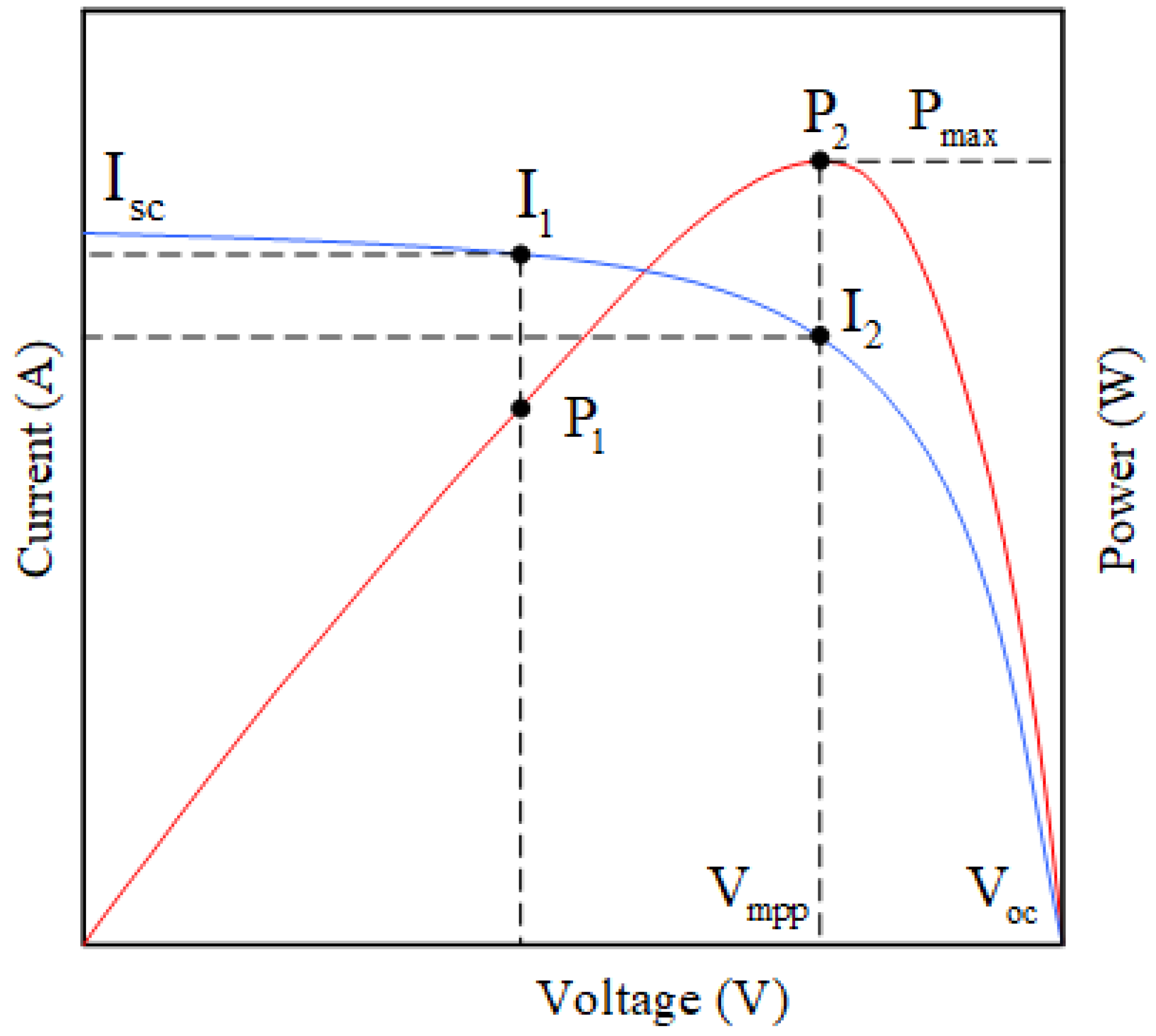
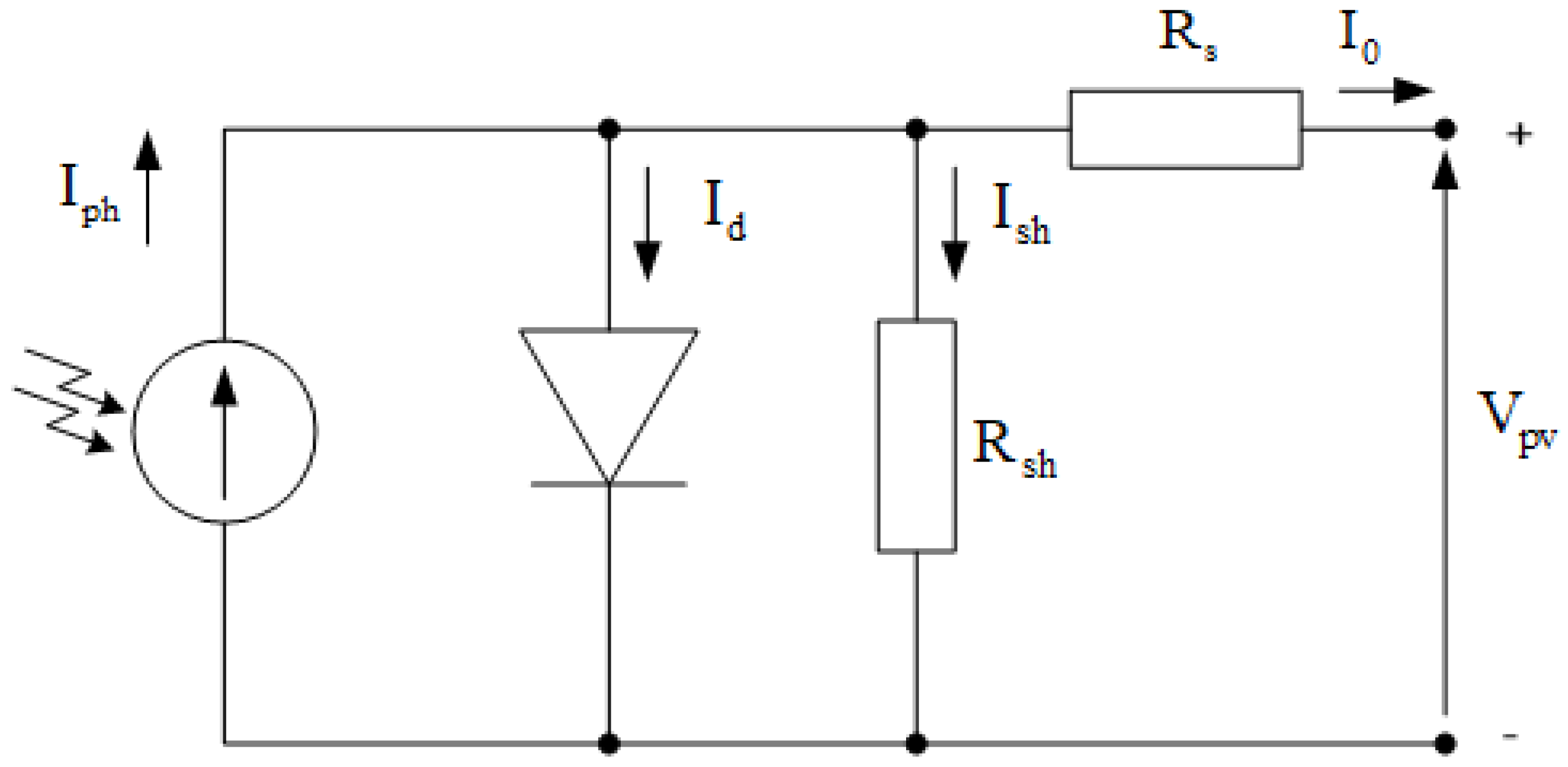

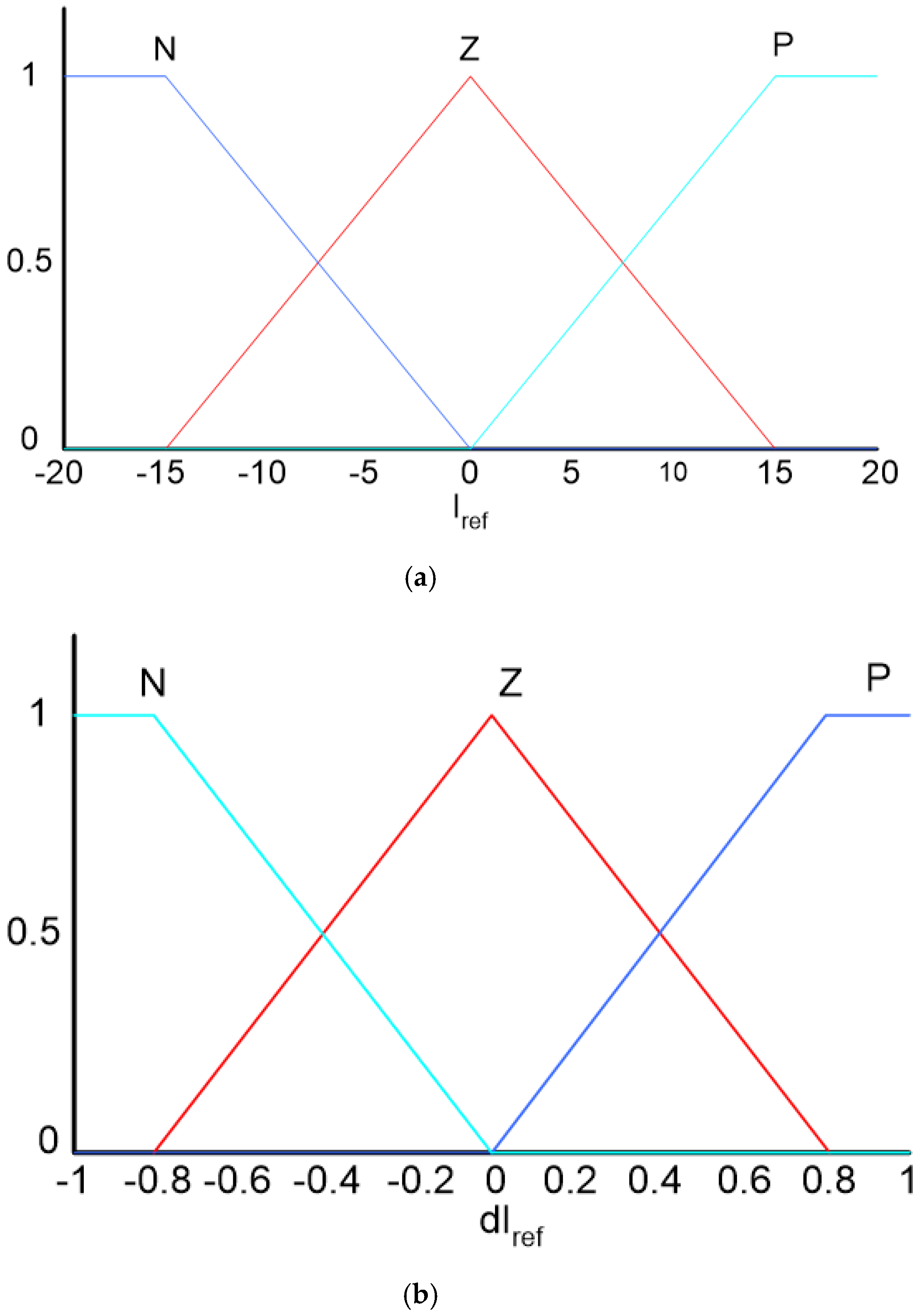

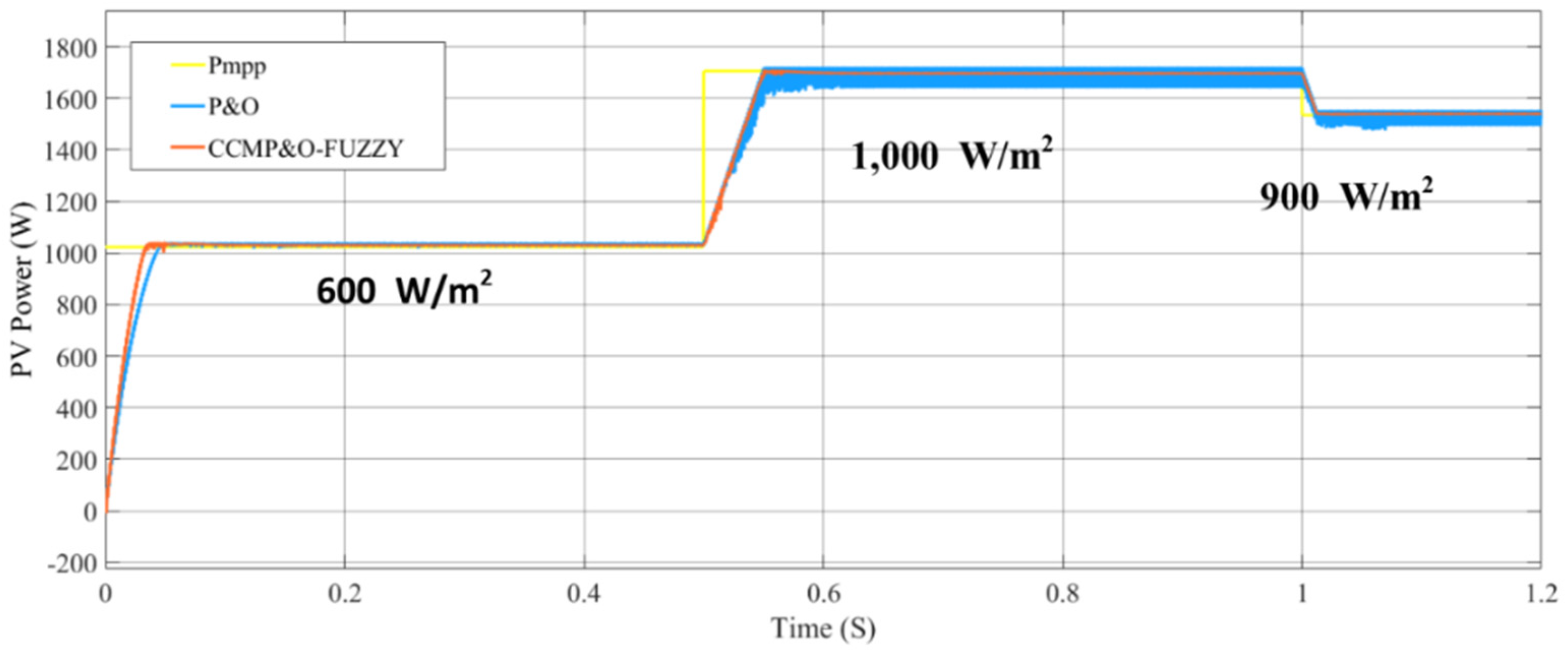

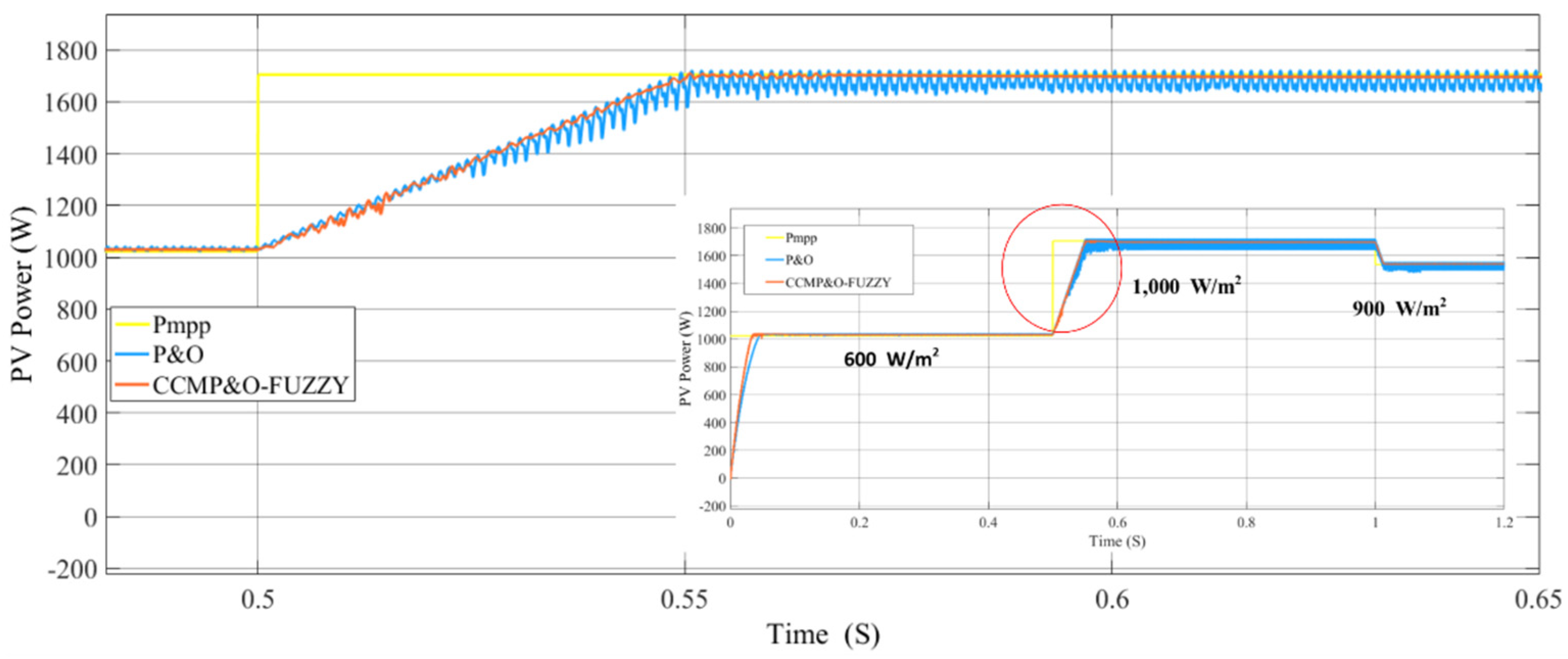
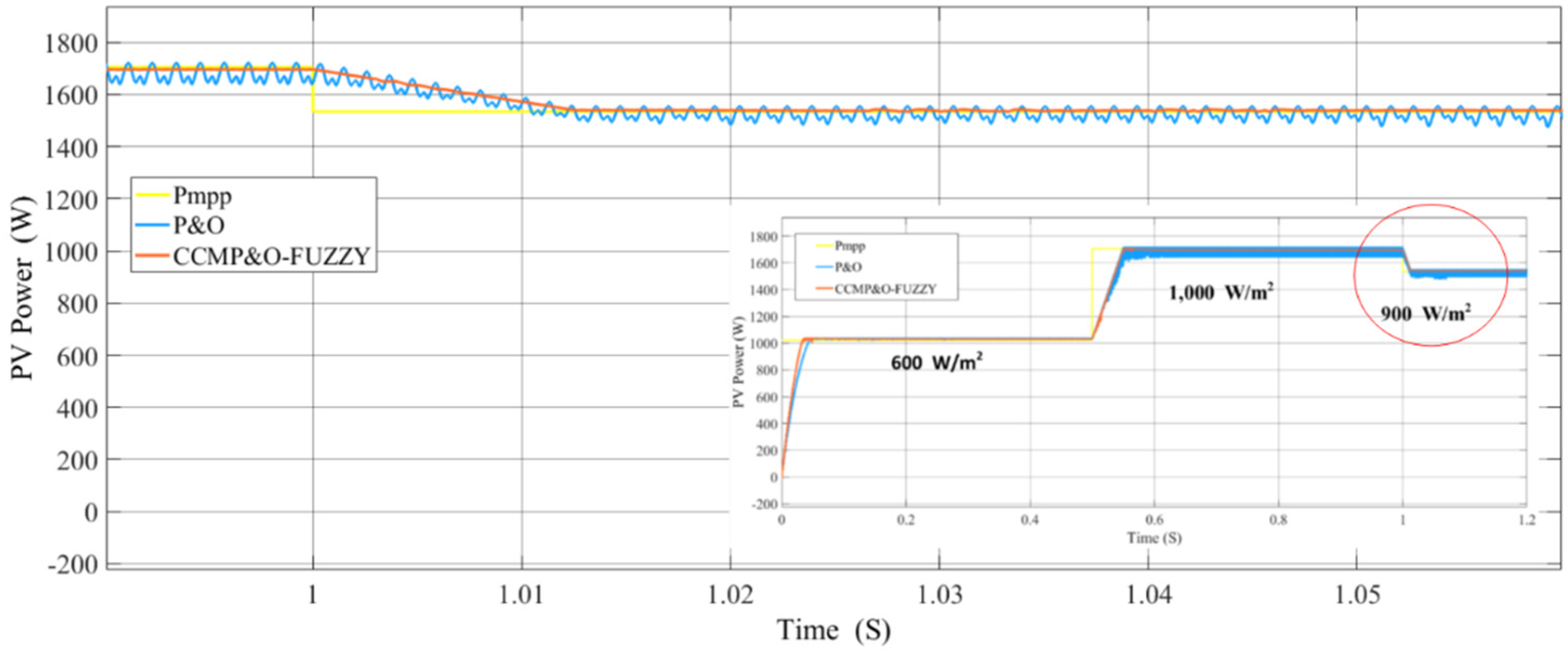
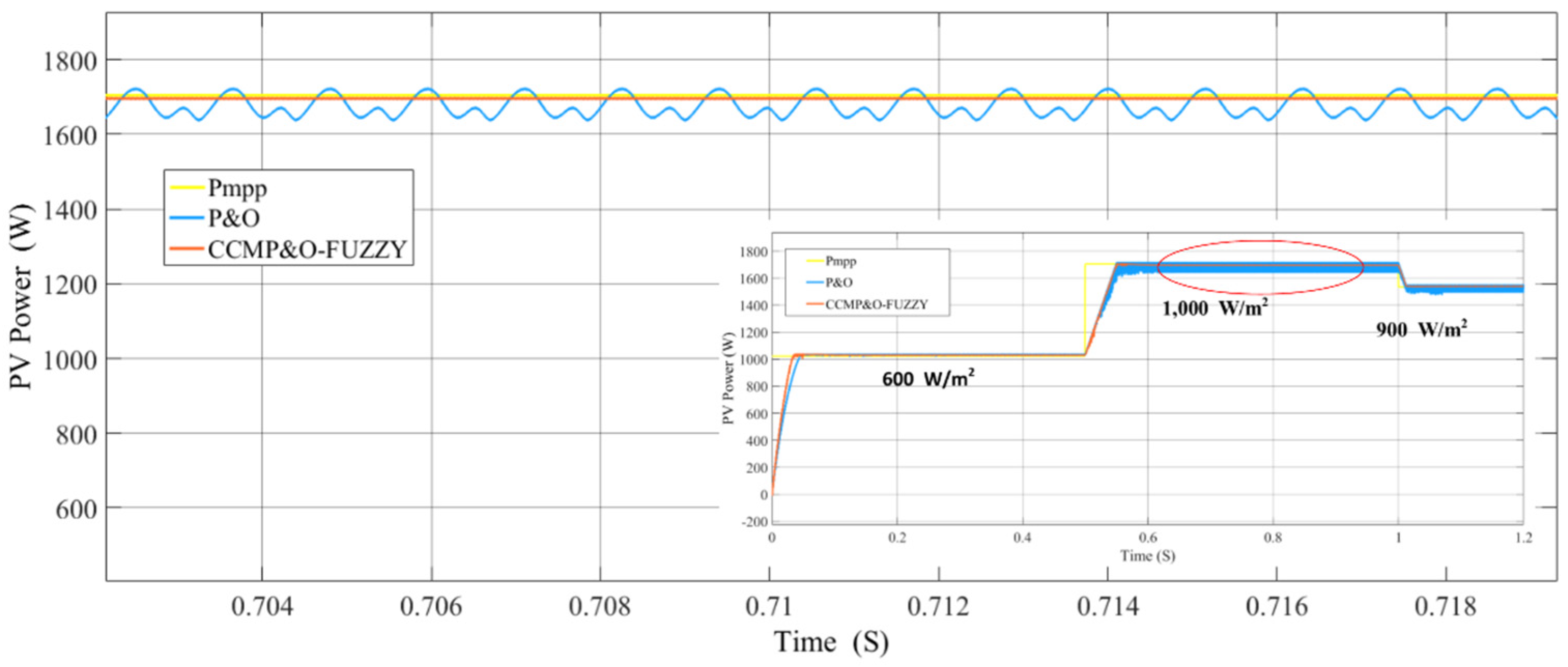
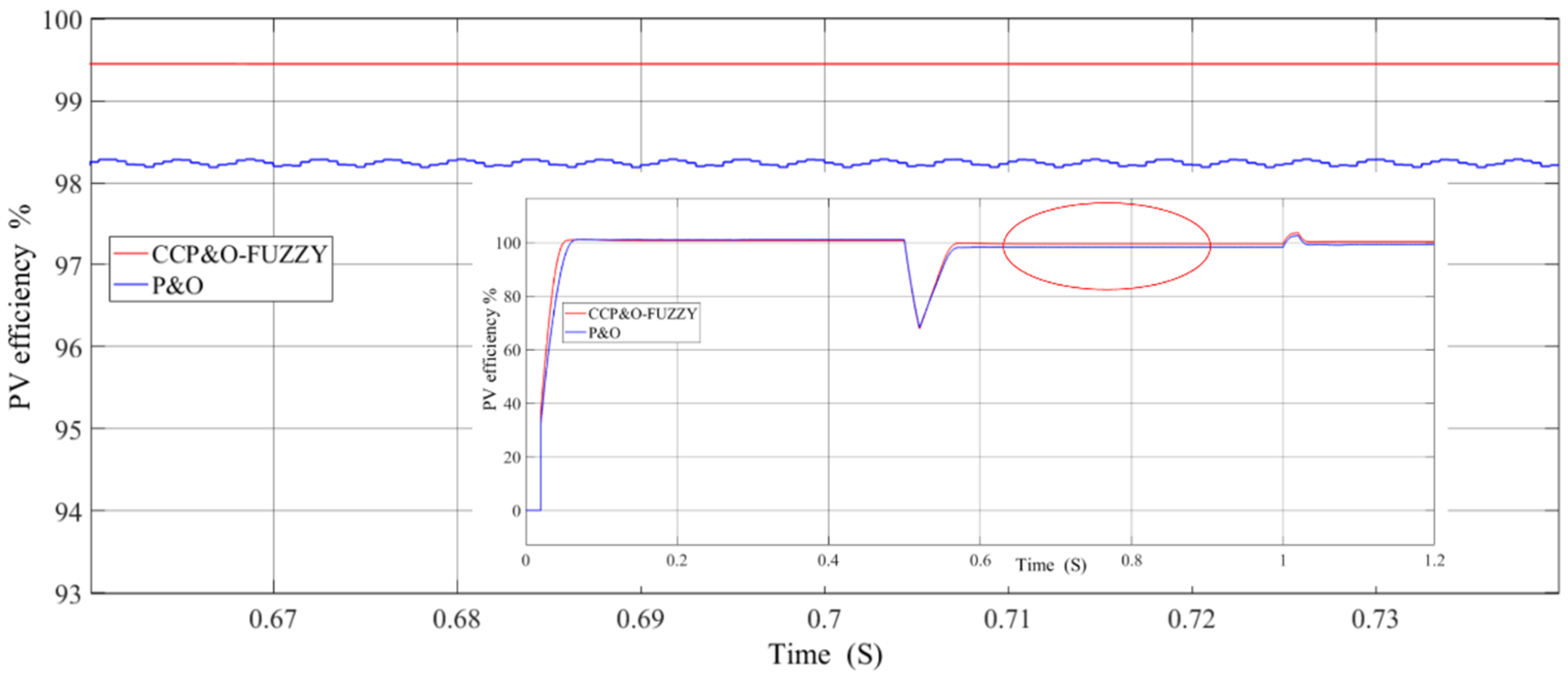



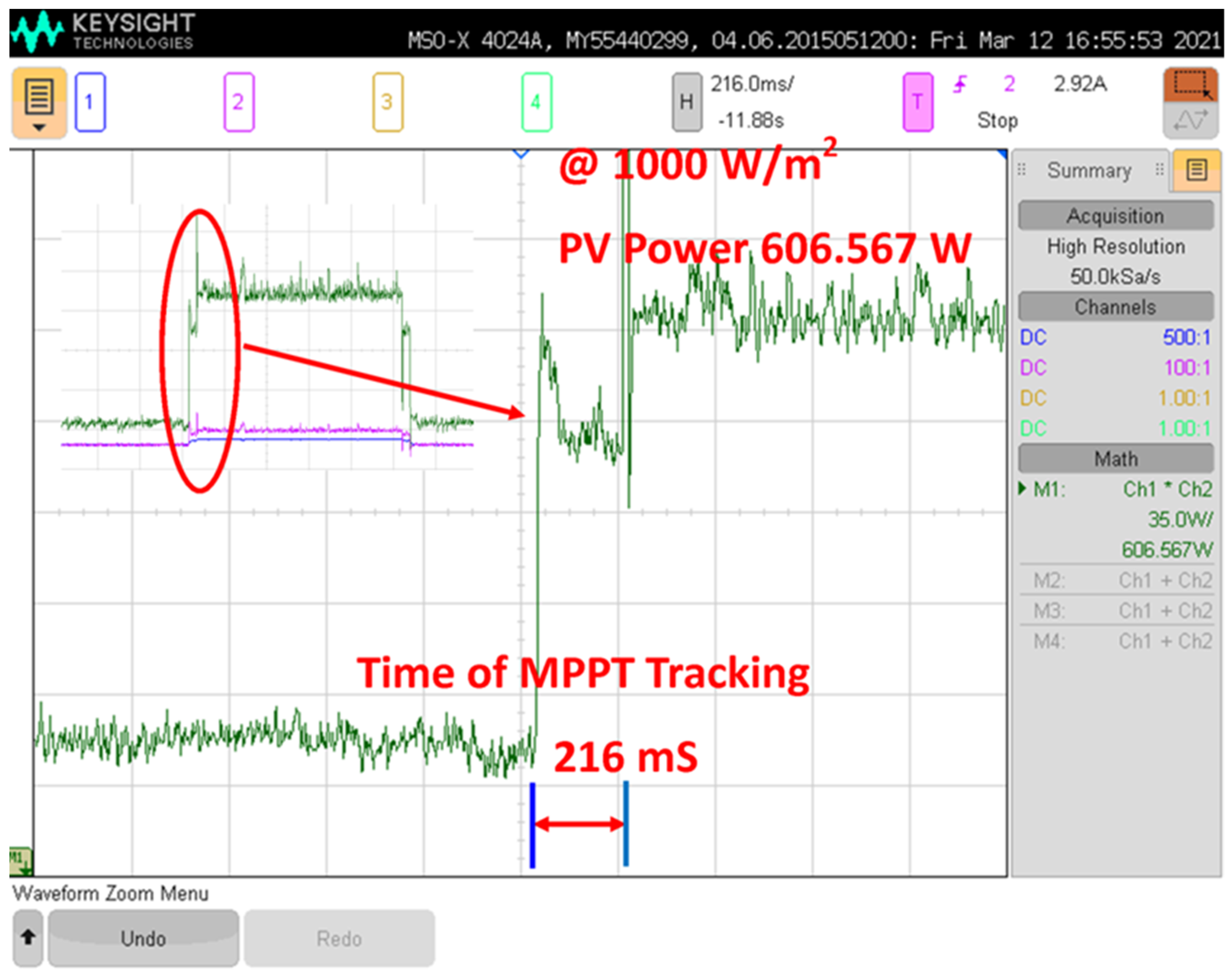
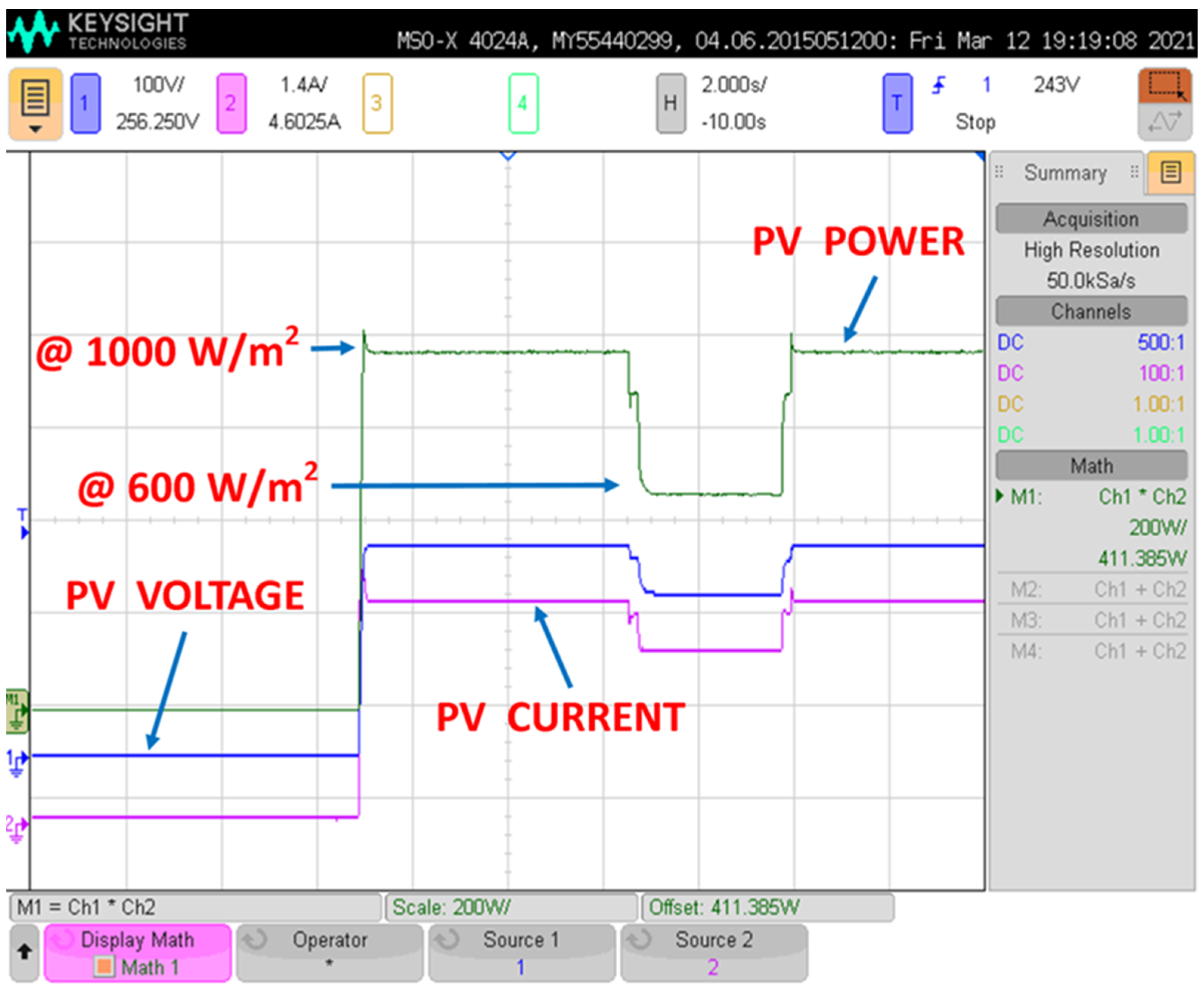
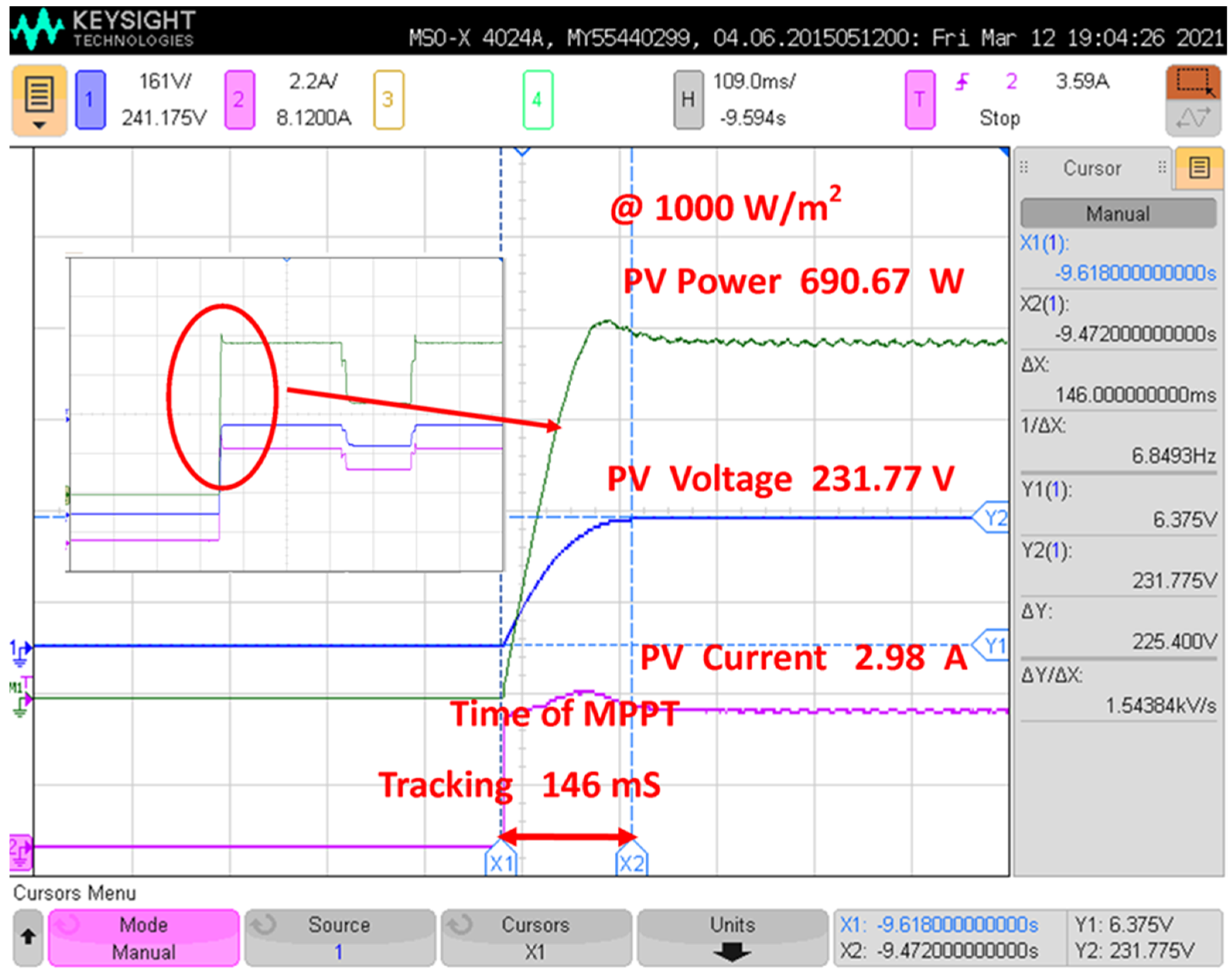
| MPPT Method | Converter | Equipment | Outcomes | Ref |
|---|---|---|---|---|
| EA-P&O | buck-boost | MATLAB/Simulink DS1104 DSP | Good tracking under partial shading High efficiency | [9] |
| SOFT-MPPT | boost | Arduino mega 2560 microcontroller | Fast-tracking under changing irradiance | [21] |
| MP&O-FLC | boost | MATLAB/Simulink dSPACE | Fast response under changing irradiance Low steady-state oscillation around MPPT | [22] |
| Neuro-Fuzzy | buck-boost | MATLAB/Simulink | High performance under changing irradiance | [23] |
| AFL-MPPT | boost | TMS320F28335 microcontroller | High tracking efficiency Fast dynamics | [24] |
| dErr | N | Z | P | |
|---|---|---|---|---|
| Err | ||||
| N | Z | Z | Z | |
| Z | Z | Z | S | |
| P | S | M | L | |
| Emulated PV Source Specifications | Value |
|---|---|
| Voltage at MPP (Vmpp) | 29 V |
| Current at MPP (Impp) | 7.35 A |
| Short circuit current (Isc) | 7.84 A |
| Open circuit voltage (Vsc) | 36.3 V |
| Maximum power at standard temperature condition | 213.15 W |
| Parallel strings | 1 |
| Series-connected modules per string | 8 |
| Converter Parameter | Value |
|---|---|
| Switching frequency (fsw) | 20 kHz |
| Input filter capacitor (Cin) | 100 μF |
| Output filter capacitor (Co) | 280 μF |
| Input filter inductor (Lin) | 420 mH |
| Emulated PV Source Specifications | Value |
|---|---|
| Voltage at MPP (Vmpp) | 230 V |
| Current at MPP (Impp) | 3 A |
| Short circuit current (Isc) | 4 A |
| Open circuit voltage (Vsc) | 245 V |
| Temperature coefficient (Tk) | −1000 °C |
| DC/DC Boost Converter Parameter | Value |
|---|---|
| Switching frequency (fw) | 20 kHz |
| Input filter capacitor (Cin) | 100 μF |
| Output filter capacitor (Co) | 280 μF |
| Input filter inductor (Lin) | 420 mH |
Publisher’s Note: MDPI stays neutral with regard to jurisdictional claims in published maps and institutional affiliations. |
© 2021 by the authors. Licensee MDPI, Basel, Switzerland. This article is an open access article distributed under the terms and conditions of the Creative Commons Attribution (CC BY) license (https://creativecommons.org/licenses/by/4.0/).
Share and Cite
Aurairat, A.; Plangklang, B. An Alternative Perturbation and Observation Modifier Maximum Power Point Tracking of PV Systems. Symmetry 2022, 14, 44. https://doi.org/10.3390/sym14010044
Aurairat A, Plangklang B. An Alternative Perturbation and Observation Modifier Maximum Power Point Tracking of PV Systems. Symmetry. 2022; 14(1):44. https://doi.org/10.3390/sym14010044
Chicago/Turabian StyleAurairat, Anuchit, and Boonyang Plangklang. 2022. "An Alternative Perturbation and Observation Modifier Maximum Power Point Tracking of PV Systems" Symmetry 14, no. 1: 44. https://doi.org/10.3390/sym14010044
APA StyleAurairat, A., & Plangklang, B. (2022). An Alternative Perturbation and Observation Modifier Maximum Power Point Tracking of PV Systems. Symmetry, 14(1), 44. https://doi.org/10.3390/sym14010044







